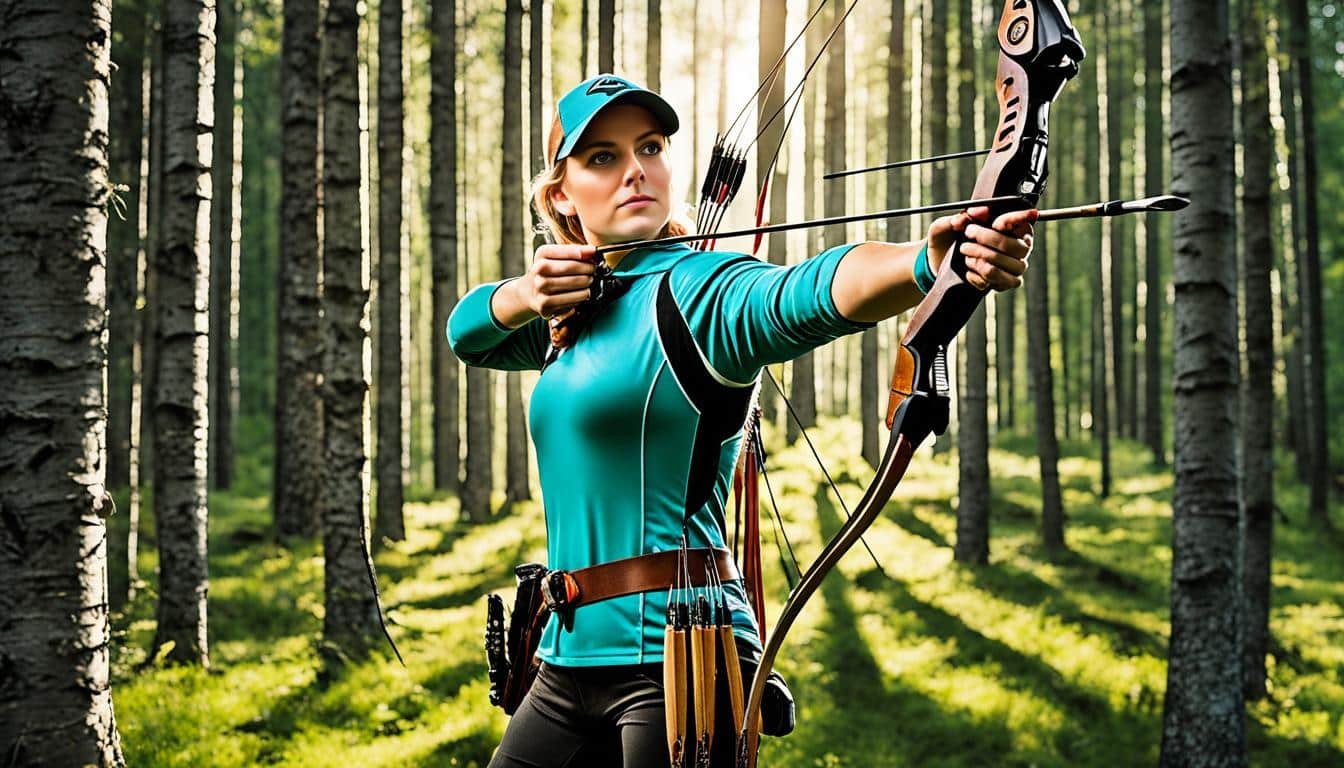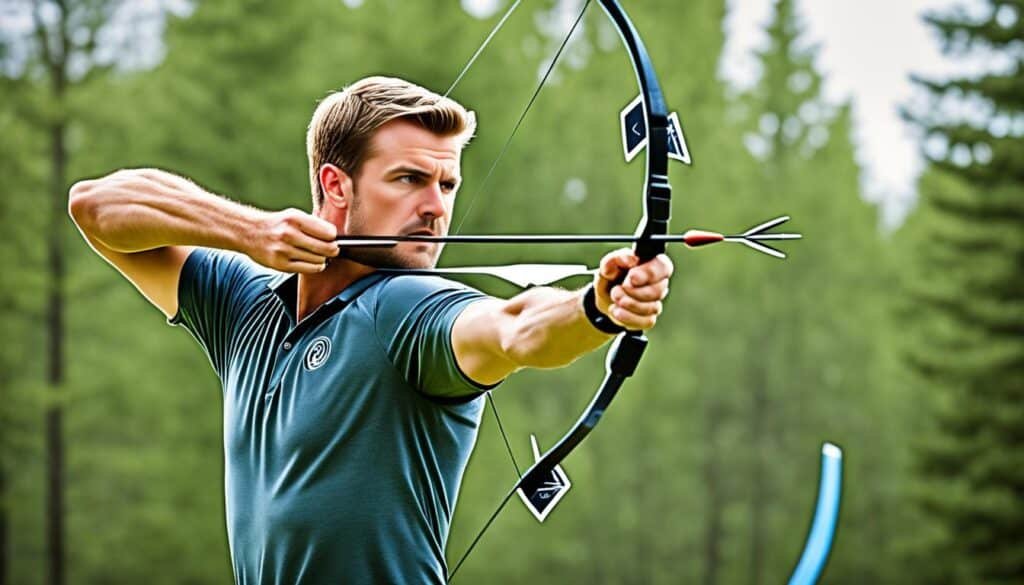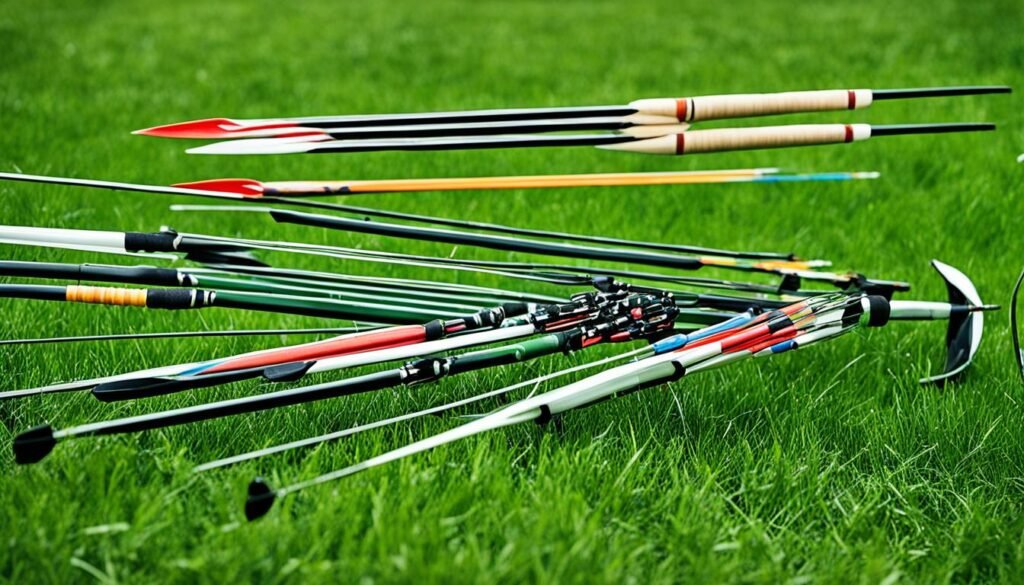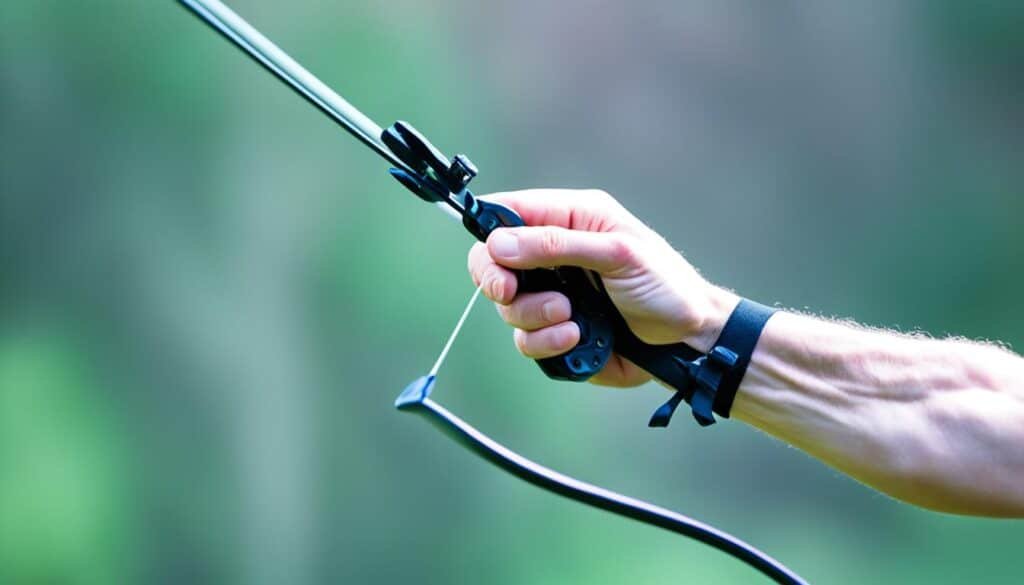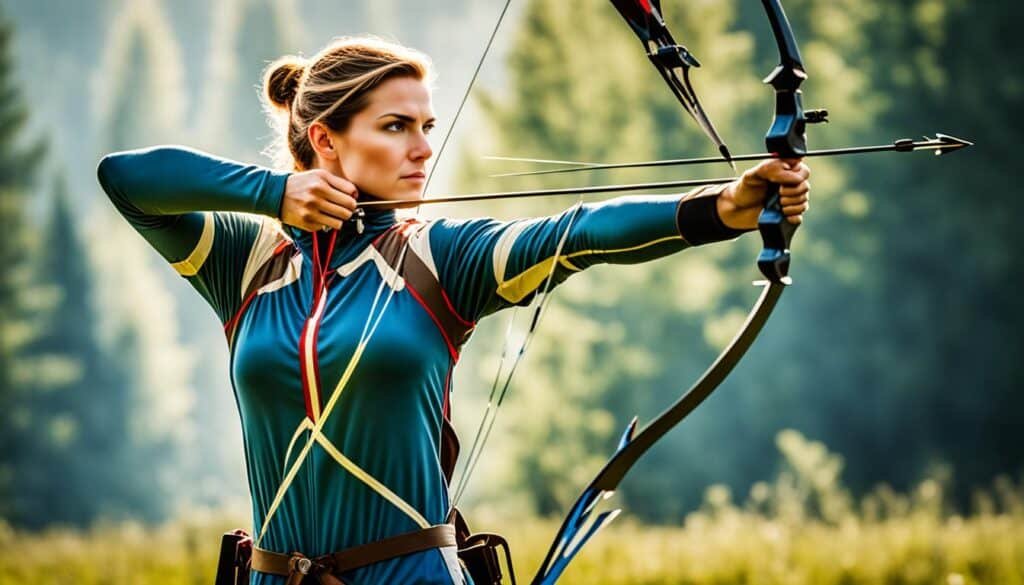Archery is a captivating sport that requires skill, precision, and dedication. Whether you are a beginner or already have some experience, this comprehensive guide will provide you with expert tips and techniques to help you master archery. We will also dive into the essential archery gear you need to enhance your skills and take your performance to the next level.
Key Takeaways:
- Archery is a sport that demands skill, precision, and practice.
- This guide offers expert tips and techniques to help you become a master archer.
- Essential archery gear includes bows, arrows, and accessories.
- Proper form, consistent practice, and adjusting for environmental factors are key to improving accuracy and consistency.
- Fine-tuning technique and familiarizing yourself with archery equipment are essential for mastering the sport.
Tips for New Archers
If you are new to archery, there are a few tips that can help you get started.
- Visit a local bow dealer to find the perfect bow for your needs.
- Practice is essential in archery, so make sure to set up a target and engage in regular target practice.
“The beginner’s mind is the key to learning archery.”
Mastering Proper Form
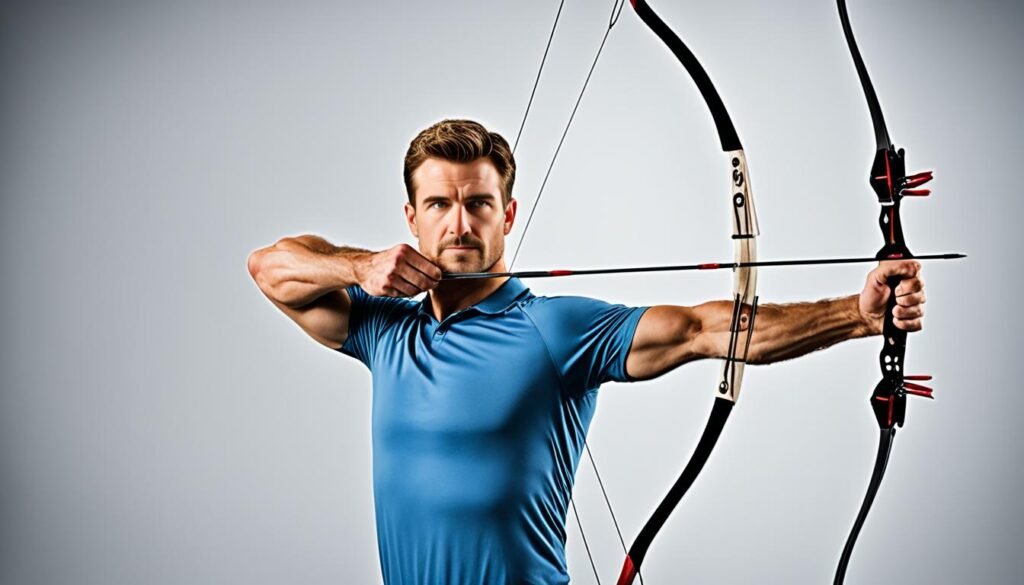
Proper form is the foundation of accurate and consistent shooting in archery. By mastering the correct technique, you can improve your shooting accuracy and consistency. Here are some essential aspects of proper form:
- Posture: Stand tall with your feet shoulder-width apart and perpendicular to the target. Maintain a straight back and relaxed shoulders.
- Bow Arm: Extend your bow arm fully, keeping it parallel to the ground. Ensure that your elbow is not locked or hyperextended.
- Bowstring Grip: Hold the bowstring with a relaxed and slightly open hand. Place your fingers below the arrow nock, using the tips of your fingers to create a solid connection.
- Stability: Maintain a stable stance with equal weight distribution on both feet. Avoid unnecessary movement and strive for a still and focused position.
By practicing these basics of proper form, you can enhance your archery performance and achieve greater accuracy and consistency in your shots. Consistency in technique is key to developing muscle memory and honing your skills over time.
Quote:
“Proper form is the bridge between accuracy and consistency in archery. It sets the stage for successful shots and helps to eliminate variables that can affect your performance.” – John Johnson, Archery Coach
Remember, mastering proper form takes time and practice. Regularly assess your form and make necessary adjustments to ensure that you are executing each element correctly. Developing a solid foundation in proper form will contribute significantly to your archery journey.
Importance of Practice
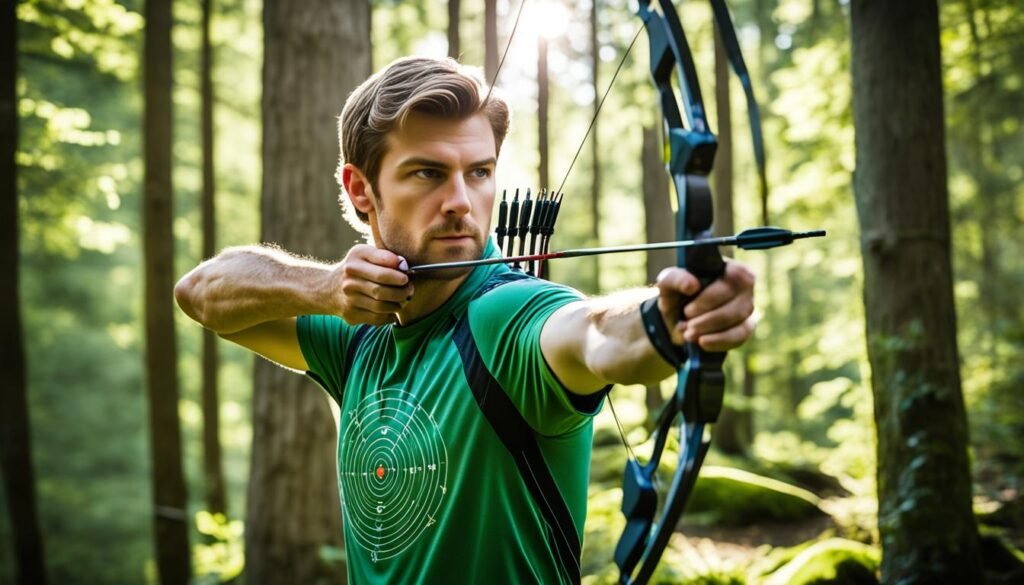
Consistent practice is crucial for improving your archery skills. Regular practice sessions not only enhance your accuracy and consistency but also allow you to identify and correct any shooting habits or areas that need improvement. By dedicating time to practice, you can develop the muscle memory necessary for accurate shooting.
Practicing archery regularly helps build strength and coordination, enabling you to shoot with greater precision. Through repetition, you reinforce the correct shooting techniques and develop consistency in your form. This consistency translates into improved accuracy, as you become more familiar with the mechanics of shooting an arrow.
Furthermore, practice helps you establish good shooting habits and break any bad ones. By focusing on proper technique during practice sessions, you can reinforce the correct form and eliminate any unnecessary movements or habits that may hinder your shooting efficiency and accuracy.
Remember, practice is not just about shooting arrows at targets. It’s about deliberate and focused repetition of the key elements of your shooting routine. Pay attention to every aspect, from your stance to your release, ensuring that each movement is precise and consistent.
Consistency in practice is also essential. Regularly setting aside time for archery practice allows you to steadily build upon your skills, reinforcing the correct techniques and gradually improving your accuracy. It’s important to establish a consistent practice routine to ensure continuous progress in your archery journey.
To help you stay motivated and track your progress, consider setting specific practice goals. These goals can be as simple as shooting a certain number of arrows each day or achieving a specific score during each practice session. By setting achievable goals and measuring your progress, you can stay motivated and focused on improving your archery skills.
Benefits of Regular Practice:
- Improved accuracy and consistency
- Identification and correction of shooting habits
- Development of muscle memory
- Establishment of good shooting habits
- Breakthrough of plateaus and continuous improvement
Tips for Effective Archery Practice:
- Set specific practice goals
- Practice with focus and deliberation
- Vary your practice routine (e.g., shooting from different distances, angles, or positions)
- Seek feedback from experienced archers or coaches
- Track your progress and celebrate milestones
To illustrate the importance of practice in archery, consider the following table that highlights the impact of consistent practice on accuracy and consistency:
| Group | Practice Frequency | Accuracy Level | Consistency Level |
|---|---|---|---|
| Group A | Practices three times a week | High | High |
| Group B | Practices once a week | Moderate | Low |
| Group C | Inconsistent practice | Low | Low |
In conclusion, practice is the key to mastering archery. By dedicating regular practice sessions, you can improve your accuracy, consistency, and shooting habits. Remember to set specific goals, practice with focus, and track your progress to stay motivated and continuously improve your archery skills.
Adjusting for Environmental Factors
When it comes to archery, environmental factors can play a significant role in the accuracy of your shots. Wind and sunlight, in particular, can pose challenges that require adjustments to your aim. Understanding how these factors affect your shooting and learning to compensate for them is crucial for improving your archery skills.
Wind: The wind can be a major hindrance during archery practice or competitions. It can easily throw your arrow off course if not accounted for. To adjust your aim in windy conditions, aim slightly to the side of your target in the direction the wind is blowing. This will help counteract the wind’s effect and increase your chances of hitting the target.
“In archery, wind is both an archer’s worst enemy and best teacher.” – Byron Ferguson
Sunlight: Lighting conditions can also impact your aim and perception of the target. Experimenting with different lighting conditions during practice sessions can help you adapt to varying situations. By familiarizing yourself with shooting in bright sunlight, low light, or shadows, you can train your eyes to make the necessary adjustments and maintain accuracy in different environments.
Environmental Factor Adjustment Technique Wind Aim slightly to the side of the target in the direction the wind is blowing. Sunlight Experiment with different lighting conditions to train your eyes to adjust aim accordingly. By practicing and honing your aim adjustment skills in various environmental conditions, you can become a more versatile archer. Remember, it takes time and experience to develop the ability to adapt to different factors that may influence your shooting. Keep pushing yourself, keep learning, and watch your archery skills soar.
Fine-Tuning Technique
Once you have mastered the basics of archery, it’s time to fine-tune your technique with advanced drills and exercises. These drills and exercises are designed to sharpen your skills, improve your form, and enhance your overall performance on the archery range.
Shooting with Your Eyes Closed
One effective drill to improve your archery technique is to practice shooting with your eyes closed. This may seem counterintuitive, but by eliminating the visual distractions, you can focus solely on your form and muscle memory. This exercise helps develop a consistent release and improves your ability to rely on your muscle memory for accuracy.
Shooting from Different Positions
Varying the shooting positions can significantly improve your balance, stability, and overall shooting performance. Experiment with shooting from kneeling, sitting, or even crouching positions to challenge yourself and adapt to different scenarios. This exercise strengthens your core, enhances stability, and encourages better body control, which translates to more accurate shots.
Practicing at Different Distances and Targets
Another way to fine-tune your archery technique is to practice shooting at different distances and targets. Set up targets at varying distances, from relatively close to farther away. This exercise helps you develop the ability to adjust your aim, gauge distances accurately, and improve your consistency at different shooting ranges. It also allows you to work on precision and accuracy, making you a more versatile archer overall.
Drills and Exercises for Fine-Tuning Technique Benefits Shooting with Your Eyes Closed – Develops muscle memoryn- Improves release consistency Shooting from Different Positions – Enhances balance and stabilityn- Improves body control Practicing at Different Distances and Targets – Enhances aim adjustment skillsn- Improves precision and accuracy To become a master archer, it’s crucial to continually challenge and refine your archery technique. By incorporating these advanced drills and exercises into your practice routine, you can fine-tune your skills, improve your form, and elevate your overall performance on the archery range.
The Basics of Archery Equipment
Before you embark on your archery journey, it’s essential to familiarize yourself with the necessary equipment. Understanding the different types of bows, arrows, and accessories will significantly enhance your archery experience.
Types of Bows
When it comes to bows, there are three primary types to consider:
- Recurve Bows: These bows have a distinct shape with limbs that curve away from the archer when unstrung. They are great for beginners due to their simplicity and versatility.
- Compound Bows: These bows utilize a system of cables and pulleys to generate power. They offer increased accuracy and are commonly used in competitive archery.
- Traditional Longbows: These bows have a classic design dating back centuries. They require more skill to shoot effectively but provide a unique and traditional archery experience.
Various Arrows
Arrows are available in different materials, each offering unique characteristics:
- Aluminum: These arrows are durable and suitable for beginners.
- Carbon: Carbon arrows are lightweight and offer increased speed and accuracy.
- Wood: Wooden arrows provide a traditional feel and are commonly used in traditional archery.
Must-Have Accessories
In addition to bows and arrows, there are several essential accessories to consider:
- Armguard: Protects your forearm from the bowstring during release.
- Finger Tab or Glove: Provides finger protection and enhances your grip on the bowstring.
- Bow Stringer: A tool used to string and unstring recurve bows safely.
- Quiver: A container for carrying your arrows during practice or competitions.
Now that you are familiar with the basics of archery equipment, you can confidently begin your archery journey. The right equipment will set you up for success and enable you to enjoy this incredible sport to its fullest.
Basic Archery Techniques and Safety Tips
In order to shoot accurately and safely in archery, it’s crucial to learn and practice the fundamental techniques. By mastering these techniques, you can enhance your precision and enjoy a safe archery experience. Additionally, adhering to safety tips will help you avoid injury and create a secure environment for yourself and others.
Proper Stance
Establishing a proper stance is essential for maintaining balance and stability while shooting. Stand with your feet shoulder-width apart and perpendicular to the target. Distribute your weight evenly on both feet, with a slightly bent forward posture.
Nocking and Gripping the Bow
When nocking the arrow, ensure that the arrow’s nock is properly seated on the bowstring. The index feather or vane should be facing outwards. When gripping the bow, use a relaxed and comfortable grip that allows you to maintain control without causing tension in your hand and forearm.
Drawing and Anchoring the Bowstring
Draw the bowstring smoothly, using the muscles of your back rather than relying solely on your arm strength. Place your drawing hand near the corner of your mouth, where you find a comfortable and consistent anchor point. This anchor point ensures consistent shooting and promotes accuracy.
Aiming Techniques
Aiming is a crucial aspect of archery. There are various aiming techniques, such as the gap method, where you align your target with a visual reference point on your bow or arrow. Alternatively, you can use the instinctive method, relying on muscle memory and developing an innate sense of aiming without conscious reference points.
Releasing the Arrow Smoothly
Release the arrow smoothly by maintaining a relaxed grip on the bowstring. Avoid jerking or twisting your fingers during the release, as this can negatively impact arrow flight and accuracy. Focus on keeping a consistent and controlled release throughout your shooting.
Safety Tips
- Always follow the range rules and guidelines.
- Wear appropriate protective gear, such as an armguard and finger tab or glove.
- Check your equipment regularly for any signs of wear or damage.
- Never point your bow and arrow at anything other than the target.
- Make sure there are no people or obstacles in your shooting range.
- Practice situational awareness and be mindful of your surroundings.
To illustrate the correct archery techniques and safety tips, refer to the image below:
By practicing these basic archery techniques and adhering to safety guidelines, you can ensure a satisfying and secure archery experience. Now that you have mastered the basics, it’s time to delve into more advanced techniques and drills to refine your skills further.
Independent Practice vs. Joining a Club
As a beginner archer, you have the option to practice independently or join a local archery club. Both options have their advantages and considerations to take into account. Ultimately, your decision should be based on your individual preferences and goals.
Independent practice offers flexibility and convenience. You have the freedom to practice whenever and wherever you want. This can be particularly beneficial if you have a busy schedule or limited access to a local archery club. Additionally, practicing on your own allows you to focus solely on your own progress and development as an archer.
On the other hand, joining a local archery club provides several benefits. Most clubs have experienced coaches who can provide guidance, instruction, and valuable feedback on your technique. They can help you identify areas for improvement and offer personalized training strategies. Being part of a club also gives you the opportunity to socialize and connect with fellow archers who share your passion for archery. This sense of community can be motivating and inspiring as you work towards your goals.
When deciding between independent practice and joining a club, consider your goals. If you have specific targets you want to achieve, such as competing in archery tournaments or progressing to advanced levels, joining a club can provide the resources and support you need. However, if you prefer a more relaxed approach to archery and value the flexibility of practicing on your own terms, independent practice may be the better choice for you.
Ultimately, there is no right or wrong answer when it comes to choosing between independent practice and joining a club. It all depends on your personal preferences and what aligns with your archery journey. Consider trying both options and see which one suits you best.
Remember, whether you choose to practice independently or join a club, the most important thing is to stay dedicated and consistent in your archery practice. With time, patience, and perseverance, you can develop your skills and become a proficient archer.
Setting Goals and Tracking Progress
Improving your archery skills requires setting clear goals and diligently tracking your progress. By creating specific and measurable goals that align with your skill level and desired outcomes, you can focus your efforts and stay motivated on your archery journey.
Monitoring your performance is crucial for identifying areas of improvement and making necessary adjustments. Whether you’re aiming to enhance your accuracy, increase your shooting consistency, or reach a certain score, tracking your progress will provide valuable insights into your development as an archer.
One effective method for tracking progress is by keeping a journal dedicated to archery practice. Record your practice sessions, noting the techniques you focused on, the number of arrows shot, and any observations or reflections. This not only helps you track your scores and performance over time but also allows you to analyze patterns and identify areas that need extra attention.
An alternative to a traditional journal is using a mobile app designed specifically for archery progress tracking. These apps often feature built-in score trackers, practice logs, and performance analytics. They provide a convenient and organized way to monitor your development, plus they may offer additional features such as personalized training plans or community forums for archery enthusiasts.
Remember, capturing your progress is not just about documenting your achievements but also about celebrating milestones and acknowledging your hard work. Seeing how far you’ve come can be incredibly motivating and inspire you to push further in your archery journey.
“Setting goals is the first step in turning the invisible into the visible.” – Tony Robbins
Also Read : Master Table Tennis Basics And Tips For All Levels
Conclusion
Archery is a sport that rewards those who possess skill, patience, and dedication. By implementing the tips and techniques discussed in this guide, practicing consistently, and setting clear goals, you can embark on a fulfilling journey to become a master archer. Remember, becoming proficient in archery takes time and effort, but the rewards are well worth it.
Throughout this guide, we have covered various aspects of archery, including mastering proper form, the importance of practice, adjusting for environmental factors, and fine-tuning your technique. Additionally, we have touched on the basics of archery equipment, as well as safety tips to ensure a secure shooting experience.
Whether you choose to practice independently or join a local archery club, always remember to enjoy the process and embrace the challenges along the way. Keep track of your progress, set achievable goals, and most importantly, have fun with archery. As you continue to hone your skills, you will experience the satisfaction of hitting your targets with precision and accuracy, making archery a sport you can truly excel at.
FAQs
What are some tips for new archers?
To get started with archery, visit a local bow dealer to find the right bow for you and set up a target for regular practice.
How important is proper form in archery?
Proper form, including correct posture and bowstring grip, is crucial for accurate and consistent shooting in archery.
Why is practice important in archery?
Regular practice helps improve shooting accuracy, consistency, and allows you to identify and correct any areas that need improvement.
How do environmental factors affect archery shots?
Factors like wind and sunlight can impact your aim, and it’s essential to learn how to adjust your aim to compensate for these conditions.
How can I fine-tune my archery technique?
Advanced drills and exercises, such as shooting with your eyes closed or from different positions, can help improve balance, stability, accuracy, and precision.
What equipment do I need for archery?
You will need bows (recurve, compound, or traditional longbows), arrows, and accessories like an armguard, finger tab or glove, bow stringer, and quiver.
What are some basic archery techniques and safety tips?
Basic techniques include proper stance, nocking and gripping the bow, drawing and anchoring the bowstring, aiming techniques, and smooth release. Safety tips are crucial for avoiding injury and ensuring a safe archery experience.
Should I practice independently or join an archery club?
It depends on your preferences and goals. Independent practice offers flexibility, while joining a club provides access to experienced coaches and a community of archers.
How can I set goals and track my progress in archery?
Set specific and measurable goals, monitor your performance, and make adjustments as needed. Logging practice sessions and scores in a journal or using a mobile app can help you track your progress.
